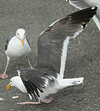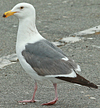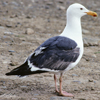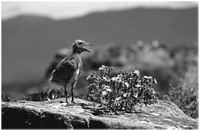|
||
Coordinators: 1cy June 2cy Jan 3cy Jan 4cy / sub-ad Jan adult Jan |
sub-adult: MayNEW LONGEVITY RECORD OF A GLAUCOUS-WINGED GULL FROM BRITISH COLUMBIA
On 21 July 1969, a Glaucous-winged Gull (Larus glaucescens) chick (Figure 1) was banded (#0807-31818) on Mitlenatch Island, British Columbia, under a master banding permit issued to the author. Mitlenatch Island is located near the northern end of the Strait of Georgia (49º 57’ 00” N, 125º 00’ 00” W) about 13 km east of Miracle Beach on Vancouver Island. It is a major seabird colony supporting breeding Glaucous-winged Gulls, Pelagic Cormorants (Phalacrocorax pelagicus), Double-crested Cormorants (P. auritus), Pigeon Guillemots (Cepphus culumba), and Black Oystercatchers(Haematopus bachmani) (Campbell et al. 1990a, 1990b). On 20 September 2006, D. Dean found the banded gull dead among beach rocks about 100 m north of the northern boundary of Kitty Coleman Park. This 10 ha marine Park is located about six kilometers northwest of Courtenay on Vancouver Island, BC and only 46 km from the gull’s natal colony. The chick was about 14 days old when banded so the calculated maximum age, including leap year days, is 37 years, 2 months, 11 days old. References: see PDF. |
occidentalis Western Gull |
 Western Gull occidentalis 3rd/4th cycle (sub-adult), May 24 2017, Monterey, California, USA. Picture: John Cant. Western Gull occidentalis 3rd/4th cycle (sub-adult), May 24 2017, Monterey, California, USA. Picture: John Cant. |
||
 Western Gull occidentalis 3rd cycle (4CY), May 24 2017, Pacific Grove, California, USA. Picture: John Cant. Western Gull occidentalis 3rd cycle (4CY), May 24 2017, Pacific Grove, California, USA. Picture: John Cant. |
||
 Western Gull occidentalis 3rd cycle (4CY), May 24 2017, Pacific Grove, California, USA. Picture: John Cant. Western Gull occidentalis 3rd cycle (4CY), May 24 2017, Pacific Grove, California, USA. Picture: John Cant. |
||
 Western Gull occidentalis sub-adult, May 05 2011, Pt. Pinos, Pacific Grove, Monterey Cty., California, USA. Picture: John Cant. Western Gull occidentalis sub-adult, May 05 2011, Pt. Pinos, Pacific Grove, Monterey Cty., California, USA. Picture: John Cant. |
||
 Western Gull occidentalis 3rd cycle (4CY), May 05 2011, Pt. Pinos, Pacific Grove, Monterey Cty., California, USA. Picture: John Cant. Western Gull occidentalis 3rd cycle (4CY), May 05 2011, Pt. Pinos, Pacific Grove, Monterey Cty., California, USA. Picture: John Cant. |
||
 Western Gull occidentalis 3rd cycle (4CY), May 05 2011, Pt. Pinos, Pacific Grove, Monterey Cty., California, USA. Picture: John Cant. Western Gull occidentalis 3rd cycle (4CY), May 05 2011, Pt. Pinos, Pacific Grove, Monterey Cty., California, USA. Picture: John Cant. |
||
 Western Gull occidentalis 3rd cycle (4CY), May 19 2017, Half Moon Bay, California, USA. Picture: John Cant. Western Gull occidentalis 3rd cycle (4CY), May 19 2017, Half Moon Bay, California, USA. Picture: John Cant. |
||
 Western Gull occidentalis 3rd cycle (4CY), May 1990, California, USA. Picture: Alex Abela. Western Gull occidentalis 3rd cycle (4CY), May 1990, California, USA. Picture: Alex Abela. |
||
 Western Gull occidentalis
Western Gull occidentalis